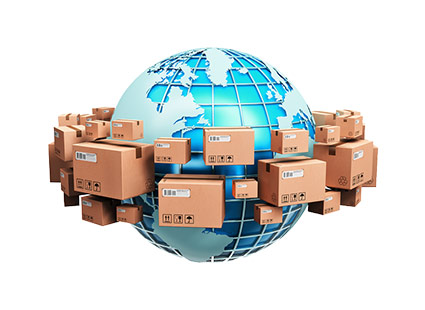Table of Contents:
- Logistics Services to Support e-Commerce & Address Challenges
- e-commerce Shipping and Logistics: Entry Type 86 Process
- Entry and eManifest Submission
- CrimsonLogic Logistics Services to Support e-commerce & Online Business
- e-commerce Managed Services
- ACE eManifest Filing
- HS Code Classification
- CFS Clearance
Global e-commerce has benefited from the pandemic, which has impacted global supply chains and changed the way people shop, with many e-retailers seeing unprecedented order volumes. Global e-commerce has benefited from the pandemic, which has impacted global supply chains and changed the way people shop, with many e-retailers seeing unprecedented order volumes. Logistics services to support e-commerce and online businesses are crucial in determining success or failure.
Logistics Services to Support E-Commerce & Address Challenges
Global e-commerce has continued to grow annually despite the pandemic, but there are key challenges that businesses must overcome to be successful.
High customer expectations.
Logistics is the crucial foundation of any e-commerce business. Customers demand fast delivery at a reasonable cost, and many are willing to pay additional fees to get their shipments sooner.
Last-mile delivery issues.
Tracking deliveries across borders and managing delivery expectations are top issues for e-commerce merchants, sellers Last-mile delivery is an area where customers tend to focus. Last-mile delivery involves moving shipments from the nearest shipping hub to its final destination.
With massive orders and sky-high expectations, there’s a lot of pressure to get this final step right. Many issues can arise, like delays with the local courier and lost packages.
Customs compliance.
Trade laws and regulations are constantly changing, and it can be difficult for businesses to keep up particularly for small and medium-sized enterprises (SME). Navigating customs compliance is the number one challenge forerchants, sellers and players in cross-border e-commerce. The e-commerce explosion has added another layer of complexity to the confusing customs clearance process.
U.S. Customs and Border Protection (CBP) must risk assess and process a massive amount of parcels every hour. CBP is constantly rolling out programs to relieve the administrative burden on the government while supporting e-commerce trade.
In 2016, the Obama administration raised the de minimis threshold from $200 to $800, causing other countries to follow suit and increase the volume of low-value goods entering the country. Mexico and Canada recently raised their de minimis values, allowing American buyers to easily shop and return items from these two NAFTA member nations.
CBP also rolled out entry Type 86 in 2019 to extend the coverage of the Section 321 release option in all modes of transport and shipment types regulated by partner government agencies (PGAs). This is a huge benefit for e-commerce merchants, sellers and players not only in terms of expedited customs clearance but also in opening the U.S. market for smaller players around the world.
e-Commerce Shipping and Logistics: Entry Type 86 Process
Entry type 86 requires the reporting of the standard shipment data which includes a 10-digit Harmonized Tariff System of the United States (HTSUS) code that identifies the exact nature of the product entering the country. The HTS code helps CBP officials with targeting and risk assessment and determines any applicable duties and taxes
Entry type 86 data must be electronically submitted to CBP before arrival or upon arrival but no later than 15 days after the cargo enters the United States. If everything is in order, shipments are cleared right away and can be delivered immediately to the consignee or warehouse.
It is the responsibility of the importer of record or their authorized representatives to file the entry requirements via the Automated Broker Interface in the Automated Commercial Environment (ACE). Filers can establish their own Electronic Data Interchange (EDI) connectivity with CBP or use third-party software and services.
Third-party software and filing services are recommended for SMEs and high-volume importers who need a cost-effective filing solution. Third-party providers can also help with HS code classification for e-commerce imports.
For businesses shipping overseas, it can be difficult to understand and prepare data in country-specific data filing format. For example, HS codes of e-commerce shipments importing from Asia often requires a lot of validation. HTS codes used in a particular country might not be used for another. Another challenge is working with commodity description in foreign languages which needs converting and further classifying before reporting to U.S. Customs
Entry Type 86 and eManifest Submission
Entry Type 86 is a voluntary option but can expedite the release process. Importers can still use the regular Section 321 release process without needing to submit the HTSUS code with ACE eManifest Shipment can be cleared at the border with ACE highway eManifest submission to the CBP for non-PGA goods.
Highway eManifests must be validated by CBP at least an hour before arrival at the border. eManifests can be submitted via the CBP ACE Portal but suitable only for low-volume filers. There’s a limit to the number of eManifests you can file in a year, and you can only prepare one eManifest at a time. Most carriers use in-house EDI connectivity or third-party software and service to file eManifests.
Before the introduction of Type 86, many e-commerce shipments were clearing through ECCF which enables expedited shipment release, though come with a high cost per parcel. CBP charges $1 per parcel for clearing through an ECCF, but parcels cleared through a CFS are not charged this merchandise processing fee (MPF). It has proven that Type 86 + CFS service has similar advantages of ECCF coupled with good cost savings for e-commerce imports
Now, for parcels transported by air carriers, entry Type 86 combines the best of ECCF (Express Consignment Carrier Facility) and CFS (Container Freight Station) processing. Clearance is fast and there’s no ECCF CBP fee per parcel allowing traders to increase import volumes while saving money. If using regular Section 321 release, CFS clearance can be a cost-effective option for parcels that are not time sensitive.
CrimsonLogic Logistics Services to Support e-Commerce & Online Businesses

CrimsonLogic is a provider of advanced logistics services to support e-commerce and online businesses
e-Commerce Managed Services
CrimsonLogic e-commerce Managed Services combines advanced technology with compliance expertise to streamline customs processing and speed up the release of low-value e-commerce shipments. The service feature customs brokerage assistance, logistics arrangements, automated shipment clearance, airport ground handling, and deconsolidation for last-mile deliveries.
Integrated Platform for ACE eManifest, Customs Security Filing, Electronic Release
CrimsonLogic has offering Customs compliance solutions for 30 years. The web solution allows trade participants to direct file shipment data with smart data validation, auto-fill tools, quick uploads, and fast submission that returns responses instantly from Customs authorities. Data can also be seamlessly integrated with freight management software to automate workflows.
Data Preparation and HS Code Classification
For overseas shippers, it is difficult to understand and prepare data in country-specific data filing format for Customs filing. HS code classification is tedious, time consuming and best left to experts. CrimsonLogic technology and services can assist with HS recommendation and data transformation for Type 86 entries to speed up the reporting of high-volume parcels.
CFS Clearance
CrimsonLogic CFS service offers more port options making it more flexible than using a ECCF. Because it is not an express release, CFS supports PGA goods and you do not need to pay the MPF. While clearance time is slightly longer than a ECCF, there are significant cost savings and offers more flexible options.
Learn more by visiting our page on logistics services to support e-commerce & online businesses or contact us today!





